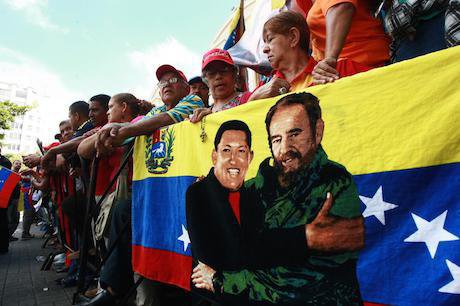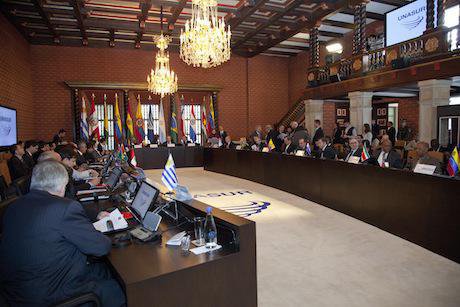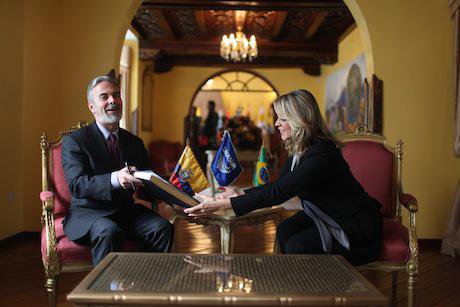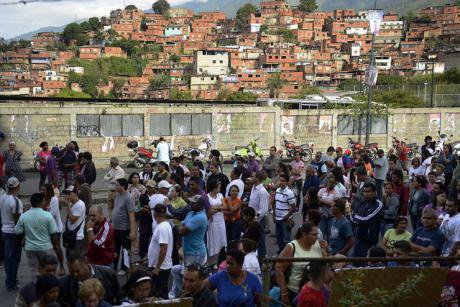
South America with flags. patrice6000/Shutterstock. All rights reserved.Since its rather humble beginnings, Latin America’s regional integration has made substantial progress towards establishing Simon Bolivar’s dream of La Patria Grande in the contemporary context. Its first tentative steps were meetings between Hugo Chavez and Fidel Castro in Havana that began in December 1994 before the former was elected to the presidency of Venezuela. This relation turned out to be strategic since building a united Latin America free from US domination has been a central objective of the Cuban Revolution since 1959.
As a result of these meetings between Fidel and Hugo, ALBA (Bolivarian Alliance for the Americas) was established on 14 December 2004 around a Cuba-Venezuela agreement to exchange 96,000 barrels of oil per day for 20,000 health workers, most of them medical doctors. Both leaders conceived ALBA as an alternative to ALCA (FTAA) advocated by George W. Bush. At its inception in 2004 ALBA had only two members: Cuba and Venezuela. By 2005, Argentina and Brazil had elected left-wing governments who together with Venezuela and other administrations in the region managed to sink the ALCA project at the Summit of the Americas held in Mar del Plata, Argentina in 2005.
ALBA is the most radical manifestation of the integration process and it is made up of eleven countries: Cuba, Venezuela, Bolivia, Nicaragua, Dominica, Antigua and Barbuda, Ecuador, St Vincent and the Grenadines, Saint Lucia, St Kitts and Nevis, and Grenada; additionally, Surinam and Haiti have been granted special status. ALBA is based on the idea of regional integration based on the principles of solidarity, social justice, complementarity, and cooperation aimed at transforming geopolitical relations in the western hemisphere.
ALBA is also a political and economic alliance organised to defend the national sovereignty of its members, and the identity of the peoples who are part of it. ALBA’s historic precedents are to be found in the thought and actions of leading intellectuals and revolutionaries from the past such as Bolívar, Martí, Sandino, Che Guevara, Tupac Amaru, Tupac Katari, Miguel Hidalgo and many other historic leaders over the centuries who have contributed to the idea of Nuestra America (Our America).

Venezuelans show support for elected Directors of National Assembly. Jesus Gil/Demotix. All rights reserved.ALBA is inimical to US hegemony in the crucial region of Central America and the Caribbean and its consolidation has proved to be contagious in less radical members of the community of states that make up Latin America. Hence powerful forces that wish to uphold the status quo and erase such a challenge have struck back with customary vigour but with substantially less effectiveness than in the past. In 2009 these forces, embedded in key bodies of the US state apparatus, engineered the coup d’état in Honduras, then a member of ALBA, in order to weaken it and to stop its growth both organizationally as well as in its political influence in the continent and internationally.
Honduras, under the leadership of radical landowner Manuel Zelaya, joined ALBA and made moves to hold a referendum to change the constitution but it also announced that it would turn the US military base of Soto Cano near Tegucigalpa into a modern, civilian and commercial airport. This was not tolerated and Zelaya was overthrown on 29 June 2009 with grave negative consequences for democracy and human rights in that country. The human rights situation in Honduras is at present extremely worrying and the overall situation can be characterised as grave. Pro US forces did manage to stop Honduras from achieving its full sovereignty and the development of a new, alternative Honduras. However, they failed in their objective of eliminating ALBA.
Chavez' tireless campaign to unify and integrate Latin America led to the establishment of key bodies and institutions such as Telesur, Banco del Sur, Codesur, PetroCaribe, PetroSur, PetroAmerica, Mision Milagro, the Yo Si Puedo literacy programme, Radio Sur, Banco del ALBA, the Fondo ALBA-Caribe, and so forth, has given tangible form to the objective of an integrated and politically unified Latin America.
ALBA, always in a leadership role, has begun commercial transactions in the SUCRE (Unified System for Regional Compensation), a virtual currency, and has set up a Chamber of Payments Compensation. ALBA-Health, ALBA-Food, ALBA-Education, ALBA-Culture, figure among other tangible examples of integration. It should be borne in mind that, despite its pioneering and radical nature, ALBA, with the notable exception of Venezuela, mainly operates in countries with small economies, which reduces its potential.

March in honour of the late Hugo Chavez. Steve Rhodes/Demotix. All rights reserved.In May 2008 all the nations of South America established UNASUR (Union of South American Nations). UNASUR had originally been a Brazilian project aimed merely at the creation of a free trade area. However, thanks to strong intervention by Bolivarian Venezuela with the crucial support of Bolivia’s Evo Morales, it has become a de facto political alliance against US interference in the internal affairs of the UNASUR nations. UNASUR, for example, played a crucial role in the defeat of the separatist, extreme right-wing racist revolt of the rich that, with US-encouragement and support, endeavoured to break up Bolivia and oust the Morales government.
UNASUR has also played a critical role in containing and opposing US destabilization plans against countries in the region, primarily Venezuela. And by having set up an Election Council that sends delegations to observe electoral processes and that issues formal reports on the probity of electoral results, UNASUR has been central to counteracting US-inspired media bias against elections results in Venezuela and other countries. Furthermore, UNASUR has supported the Maduro government in Venezuela against recent right wing attempts to oust the legitimate and democratically elected government, instead sponsoring peaceful dialogue in direct opposition to internally and externally sponsored right wing violence.
Moreover, UNASUR has declared South America a region of peace, forbids the installation of nuclear weapons in any of the member countries, and has set up CODESUR, a mechanism of collaboration on defense issues, thus making the US-inspired and US-led Inter American Reciprocal Assistance Treaty of 1947 unnecessary and potentially redundant. UNASUR has, additionally, set up regionally integrated bodies on defense, health, energy, social development, drugs, education, culture, science and technology, infrastructure and planning, and economics and finance.
UNASUR is actively constructing its own integration architecture that will soon include a Human Rights Commission which is likely to be counterposed to the usually biased OAS (Organization of American States) Human Rights bodies, but especially to the annual US State Department Human Rights Report usually deployed to discredit governments around the world (including in Latin America) –both, approved by Washington, often utilized as an excuse to interfere in the internal affairs of sovereign countries by wielding the threat of sanctions.

Meeting of UNASUR in Bogotá, Colombia. Fernanda LeMarie/Flickr. Some rights reserved.There is also MERCOSUR, a sub-regional bloc comprising Argentina, Brazil, Paraguay, Uruguay, Bolivia and Venezuela; its associate countries are Chile, Colombia, Ecuador and Peru. New Zealand and Mexico have observer status. MERCOSUR began as a purely free trade area of four countries but it has become de facto part of UNASUR and has expanded substantially since its inception in 1991 via the Treaty of Asuncion. MERCOSUR normally aligns itself with UNASUR, as it did in the recent emergency meeting (held in Brasilia in July 2015) where it sided with Venezuela's position of accepting the 1966 UN Geneva agreement as the framework for its territorial dispute with Guyana.
There is also CELAC (Community of Latin-American and Caribbean States), the largest body of regional integration that involves all 33 Latin American nations. CELAC specifically excludes the United States and Canada. CELAC is, on a quantitative level, the most comprehensive challenge to US hegemony in the western hemisphere and plays a similar political role to that of UNASUR, although its institutional development is well behind.
CELAC is likely to absorb and use existing regional integration bodies. It has been instrumental in voicing regional dissatisfaction with US exclusion of Cuba from regional summits and has expressed strong views on the need to lift the illegal US blockade against the Caribbean island. Furthermore, CELAC has made a point of fully integrating Cuba in its structures, even going as far as to give Cuba the pro-tempore presidency between 2013 and 2014.
CELAC, UNASUR and ALBA play an active and weighty role both in the conflicts caused by US plans of destabilization against progressive governments in the region, and the defense of their sovereignty. They all in different ways support the peace process in Colombia. Additionally, in 2014 CELAC declared Latin America a Zone of Peace, thus opening the possibility a substantial drive towards demilitarizing the region of US forces, especially in the Caribbean and Central America.

Ecuadorian UNASUR representative meets their Brazilian counterpart. Fernanda LeMarie/Flickr. Some rights reserved.The US Naval Base in Guantanamo, Cuba has been used for infamous purposes including gross human rights violations perpetrated by the United States. The US has currently about 36 military facilities in the region and has relaunched its Fourth Fleet (decommissioned in 1952) to patrol the Caribbean and South Atlantic, something that is rightly seen as a serious threat by most Latin American governments.
Latin America, through regional bodies such as CELAC, is likely to not just support but demand and campaign to get the US to return the Guantanamo Naval Base to Cuba. Recently, Ernesto Samper, current UNASUR’s Secretary General made an open appeal to eliminate all military bases from Latin America.
The politics underlying Latin America’s regional integration has defeated the US isolation of Cuba. This became apparent at the VI Summit of the Americas (Colombia 2012) when the region unequivocally told President Obama it would not tolerate another summit without Cuba. Thus the strong stance of the new Latin America of ALBA, UNASUR and CELAC lies at the heart of Obama’s policy of ‘normalization’ of US relations with Cuba. The same pressure explains Obama’s backtracking on his 9 March 2015 Executive Order that declared Venezuela a threat to the US national security. Likewise, Cuba’s reintegration into the Organization of American States was another manifestation of the political strength associated with regional integration.
Many governments in Latin America have come to the conclusion that they have a chance to eradicate poverty, reduce the existing gross inequalities, expand and consolidate democracy, develop a participating and conscious citizenry, grow economically, and strengthen national sovereignty only if they do it collectively. In this regard the ongoing process of regional integration is central.
This is the chief reason the US is seeking to develop the pro-market and neoliberal Pacific Alliance based in countries along the Pacific coast such as Mexico, Colombia, Peru and Chile, but which lacks the strength visible in the integration process of the rest of the continent and as a project is severely limited by the structural economic decline of the United States, which, apart from military bases, offers very little else.

People line up to cast their vote in Petare shantytown, Caracas. Globovisión/flickr. Some rights reserved.The ongoing process of regional integration in Latin America, in all its practical manifestations (Telesur, Bank of the South, PetroCaribe, etc.) and in its organizational progress (ALBA, UNASUR, CELAC) offers the region substantial areas of mutually beneficial collaboration with very positive socio-economic results: reduction of poverty, social exclusion and inequality, especially for women, black and indigenous people, and the poor.
Thus, despite undeniable complexities associated with Latin America’s structural legacy of underdevelopment and subjugation to multinational capital, the positive consequences of roughly 10 years of progressive policies – albeit applied unevenly in the region as a whole – can be seen in a huge reduction in poverty from 48 percent in 1990 to less than 27 percent in 2014 – about 100 million people.
This can also be seen in healthy average rates of growth in the last decade; massive expansion of free health care and free education; subsidized housing; elimination of IMF and World Bank influence in economic policy; substantial reduction in external endebtedness; a robust stance towards multinational capital – sometimes involving expropriation, thus reducing the latter’s traditional clout; and nationalization of key raw materials and industries, reducing foreign capital’s influence further.
Impressive steps have also been taken to eliminate racism, bigotry, gender and sex discrimination, and intolerance towards sexual diversity. In all these regards Latin America shows not only that another world is possible but is being built right now.
The region, however, confronts a US that despite some promises and gestures from President Barack Obama in seeking to normalize relations with Cuba and Venezuela, includes many broadly unaccountable and unelected US bodies which continue with a Cold War-like policy of intervention and interference in the internal affairs of many Latin American nations. Many such destabilization plans involve the large-scale illegal funding by the NED, USAID, IRI, NDI, and many other more secretive US outfits of extreme right-wing and violent groups.
Since 1998, these US bodies, sometimes with the overt support of the White House, and in cahoots with extreme right wing currents in those nations, have conducted coup d’états in Venezuela, Bolivia, Paraguay, Honduras, Ecuador, and are or have been, arguably, involved in destabilization plans in Argentina, Brazil, Nicaragua, El Salvador, Guatemala, Mexico and so on. Such coups succeeded only in Honduras and Paraguay. Had it not been for the politics of Latin America’s regional integration, there would be many more ousted governments.
Read more
Get our weekly email
Comments
We encourage anyone to comment, please consult the oD commenting guidelines if you have any questions.